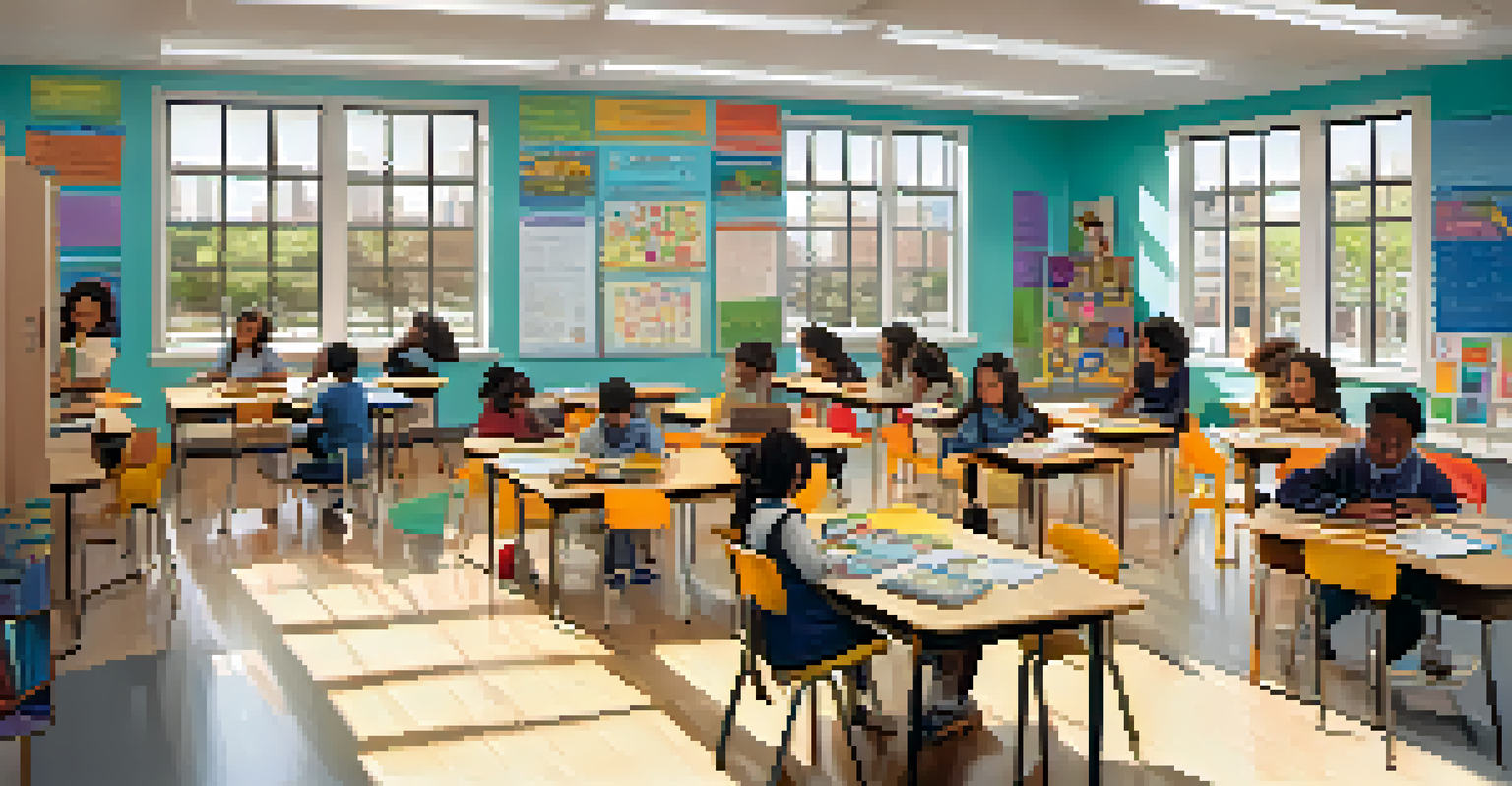Education and Economic Inequality in New York City Schools

Understanding Economic Inequality in New York City
Economic inequality in New York City is a pressing issue that impacts many aspects of life, including education. With a stark contrast between wealthy neighborhoods and those struggling with poverty, the educational landscape reflects these disparities. Families in affluent areas often have access to better resources, leading to a significant gap in educational opportunities for children.
Education is the great equalizer of our time. It gives a chance to those who otherwise would not have one.
For example, schools in wealthier districts may have advanced programs, experienced teachers, and ample extracurricular activities. In contrast, schools in lower-income areas frequently face budget cuts, overcrowded classrooms, and limited access to technology. This divide not only affects the quality of education but also shapes the future prospects of students.
As a result, children from lower-income families may find themselves at a disadvantage, struggling to keep up with their peers. This cycle of inequality perpetuates itself, making it difficult for future generations to break free from the constraints of their economic situations.
The Role of Funding in Educational Disparities
Funding is a critical factor influencing the quality of education in New York City schools. Schools are primarily funded through property taxes, which means that wealthier neighborhoods can allocate more resources to their schools. This funding model inherently favors affluent districts, creating an uneven playing field for students across the city.

Consequently, schools in lower-income areas often struggle to provide essential services such as counseling, tutoring, and special education programs. This lack of funding can lead to lower academic performance and limited opportunities for students who desperately need support. The disparity in funding not only affects day-to-day learning but also long-term outcomes, including college readiness and career opportunities.
Economic Inequality Affects Education
The stark contrast between wealthy and low-income neighborhoods in New York City significantly impacts educational opportunities for children.
Moreover, the reliance on local property taxes means that fluctuations in the housing market directly impact funding for schools. During economic downturns, schools in already struggling neighborhoods might face even more significant budget cuts, exacerbating the existing inequalities in education.
Impact of Teacher Distribution on Educational Quality
The distribution of qualified teachers plays a significant role in educational outcomes in New York City. Generally, schools in affluent areas attract more experienced and highly qualified educators, while those in economically disadvantaged neighborhoods often have a higher turnover rate and less experienced staff. This imbalance can affect the quality of education that students receive.
The function of education is to teach one to think intensively and to think critically. Intelligence plus character – that is the goal of true education.
For instance, a school with a high percentage of inexperienced teachers may struggle to provide the same level of instruction as one staffed by seasoned educators. This difference can lead to gaps in learning and comprehension, particularly in crucial subjects like mathematics and literacy. As students progress through their education, these gaps can compound, making it increasingly challenging to catch up.
Moreover, the lack of stability in staffing can negatively impact student relationships and school culture. When teachers leave frequently, it can create an environment of uncertainty for students, ultimately affecting their motivation and engagement in learning.
Access to Extracurricular Activities and Resources
Extracurricular activities play a vital role in a well-rounded education, providing students with opportunities to explore interests and develop skills outside of the classroom. In wealthier neighborhoods, schools often offer a wide range of programs, from sports teams to arts and music classes. In contrast, schools in lower-income areas may struggle to provide these essential experiences due to budget constraints.
For example, a student in an affluent school may have access to a state-of-the-art theater program, while a peer in a struggling school might not have any arts education at all. This lack of access to extracurricular activities can limit students' social development and their ability to explore diverse interests. It can also hinder college applications, as many higher education institutions look for well-rounded candidates with extracurricular involvement.
Funding Disparities Drive Inequality
School funding based on local property taxes creates a significant imbalance, favoring affluent districts and leaving lower-income schools struggling to provide essential resources.
Additionally, access to resources such as tutoring, college counseling, and test preparation can vary widely between schools. Without these resources, students in economically disadvantaged areas may find it more challenging to navigate the college application process and secure financial aid, further entrenching the cycle of inequality.
The Psychological Impact of Economic Inequality
Economic inequality can have a profound psychological impact on students, influencing their motivation, self-esteem, and overall mental health. Children from low-income families may experience stress related to their economic situation, which can manifest in anxiety and depression. These challenges can hinder their ability to focus and succeed in school.
For example, a student worried about their family's financial stability may find it difficult to concentrate on homework or participate in class discussions. This mental burden can create a cycle where students struggle academically, leading to lower self-worth and even more stress. The emotional toll of economic inequality is often overlooked but plays a critical role in educational outcomes.
Moreover, schools in low-income areas may lack the mental health resources necessary to support struggling students. Without access to counseling and support services, these children may not receive the help they need to cope with their challenges, further impeding their academic success.
Policy Initiatives Addressing Educational Inequality
In response to the pressing issue of educational inequality in New York City, various policy initiatives have been introduced to level the playing field. One approach is the implementation of funding reforms aimed at redistributing resources to schools in need. These initiatives seek to ensure that all students, regardless of their economic background, have access to quality education.
Programs such as community schools, which provide wraparound services to students and their families, have also gained traction. These schools aim to address the broader social and economic issues that impact education, offering support such as health services, after-school programs, and parental engagement opportunities. By taking a holistic approach, these initiatives strive to create a more equitable educational environment.
Community Engagement Boosts Change
Active community involvement in schools fosters innovative solutions and supports students, helping to bridge the resource gap and advocate for necessary reforms.
However, while progress has been made, challenges remain. Ongoing advocacy and community engagement are crucial to ensure that these policies are effectively implemented and that the needs of underserved students are continually addressed.
The Role of Community Engagement in Education Reform
Community engagement is essential in addressing educational inequality and fostering positive change in New York City schools. When parents, teachers, and community members come together, they can advocate for the needs of their students and push for resources and support. This collaborative effort often leads to innovative solutions tailored to the unique challenges faced by local schools.
For instance, community organizations can partner with schools to provide tutoring, mentoring, and enrichment programs, enhancing students' educational experiences. These partnerships can help bridge the gap in resources and create a supportive network for students and families. Engaging the community not only benefits the schools but also fosters a sense of ownership and pride in education.

Moreover, when communities are involved in decision-making processes, they can hold schools accountable and ensure that policies are implemented effectively. This grassroots approach can lead to more sustainable change, as it empowers families and community members to take an active role in shaping the educational landscape.